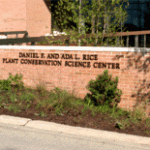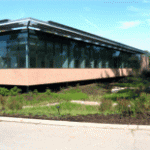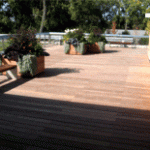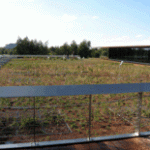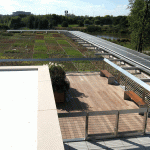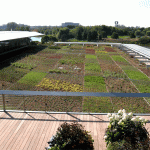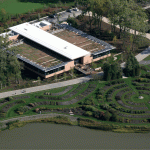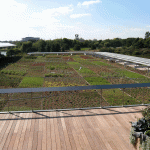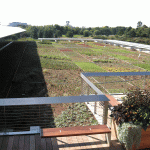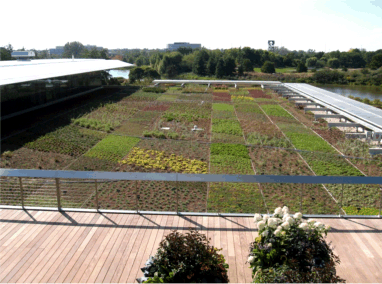
Additional Resources
The Chicago Botanic Garden is open to the public from 9 am ? 5 pm every day, and is located at 1000 Lake Cook Road, Glencoe, Illinois 60022; 847.835.5440. Visit the Daniel F. and Ada L. Rice Plant Conservation Science Center website here, and see their Green Roof page here where you can see some great videos and learn more about the plants. See the profile from the architect, Booth Hansen Architects, here, and download their Science Center Brochure here. R&D Magazine named the Daniel F. and Ada L. Rice Plant Conservation Science Center the 2010 Laboratory of the Year – read about it here.
Read about these companies in The Greenroof Directory: Sika Sarnafil and GreenGrid.
When the Chicago Botanic Garden opened its new Daniel F. and Ada L. Rice Plant Conservation Science Center in September, 2009, its stated goal was to ?Save the Plants, Save the Planet.? This 38,000 square-foot building serves as a state-of-the-art research facility and laboratory dedicated to plant conservation and public education. Booth Hansen Architects envisioned the Daniel F. and Ada L. Rice Plant Conservation Science Center as an anchor for the Chicago Botanic Garden?s 15-acre science campus. It was designed to be used by the Garden?s staff of full-time scientists and research assistants, interns, graduate students, research associates and collaborators, who will conduct research on conservation and environmental issues such as climate change, habitat loss and fragmentation, invasive species, and pollution. The facility will also serve as a teaching facility for Northwestern University?s doctoral program in plant biology and conservation. The Daniel F. and Ada L. Rice Plant Conservation Science Center was awarded LEED Gold rating by the U.S. Green Building Council.
In addition to serving as a research area, the roof also functions as a living example of sustainability technologies. The green roof avoids the urban heat island effect, captures and holds storm water, and keeps the area inside and around the building cooler. One of the low-slung building?s main ?classrooms? is its North and South Garden Roof, which features an overlook with interactive panels explaining the benefits of rooftop gardens and green roofs.
The roof was designed to be an educational environment and research facility, with the public allowed to look at the plant material while scientists experiment with different plants to see which types of plants grow best on green roofs. The goal of the evaluation program is to broaden the plant palette for the region. Three monitoring stations are located in a row on each side plus one on top of the atrium roof. In addition to monitoring plant species, they are also recording soil moisture content; light levels; heat influx from both above and what’s coming up from the building; rainfall amount, wind direction, speed, and velocity; air temperature at the ceiling; and humidity levels.
“A total of 320 different plant taxa were selected by a team of Garden staff and the lead design firm, Oehme, van Sweden & Associates. The team looked at plants that have been successful in other green roof applications as well as regional and national native plants, but didn’t want to rule out plants that showed potential. The Ellis Goodman Family Foundation Green Roof Garden South is planted with North American native plants only. The Josephine P. & John J. Louis Foundation Green Roof Garden North is planted with a mix of plants currently accepted as good green roof plants, as well as exotic and native plants that have potential for green roof use,” (Daniel F. and Ada L. Rice Plant Conservation Science Center FAQ). The actual growing space is 16,000 sf where herbaceous and woody perennials as well as grasses are being studied in growing media depths of 4″, 6″ and 8″. The growing medium consists of a mixture of expanded clay and shale, vermiculite, perlite and some sand with about 5% organic matter consisting of mostly mulch. An area also contains some GreenGrid modules for easy testing. Nesting Killdeer have established themselves on the roof along with visiting bees, butterflies and even hummingbirds.
The Chicago Botanic Garden placed a white, energy efficient roof system from Sika Sarnafil over the atrium part of the building, and a scrim-reinforced waterproofing membrane under the garden roof. The waterproofing system for the green roof included an Electric Field Vector Mapping? (EFVM?) System from ILD. EFVM uses pulses of low voltage electricity to detect roof system breaches, even with the vegetative cover in place. The breach can then be easily identified and repaired.
The composition of the green roof was interesting. The first three layers consisted of a 5/8? gypsum board, the EFVM grounding screen, and a felt separation. A Sarnafil? waterproofing membrane was loose laid on top of that, followed by the EFVM conductors (consisting of a wire around the perimeter of the roof) and another felt separation. Extruded polystyrene insulation, a water retention mat and a water retention/ drainage panel consisting of cups filled with minerals and soil came next. A filter fabric went on top of that, followed by the plants and growing media. This media ranged from four to eight inches thick, depending on the plants. A slotted aluminum angle separated the growing media from areas of free draining gravel. In addition to the green roof and white roofing membrane, the Chicago Botanic Garden also features 288 photovoltaic panels on the roof overhangs, which supply about six percent of the building?s energy needs through the 54.7kW system. The Green Roof Garden at the Plant Science Center was made possible by the generous support of the Ellis Goodman Family Foundation and the Josephine P. & John J. Louis Foundation.
 Greenroofs.comConnecting the Planet + Living Architecture
Greenroofs.comConnecting the Planet + Living Architecture
